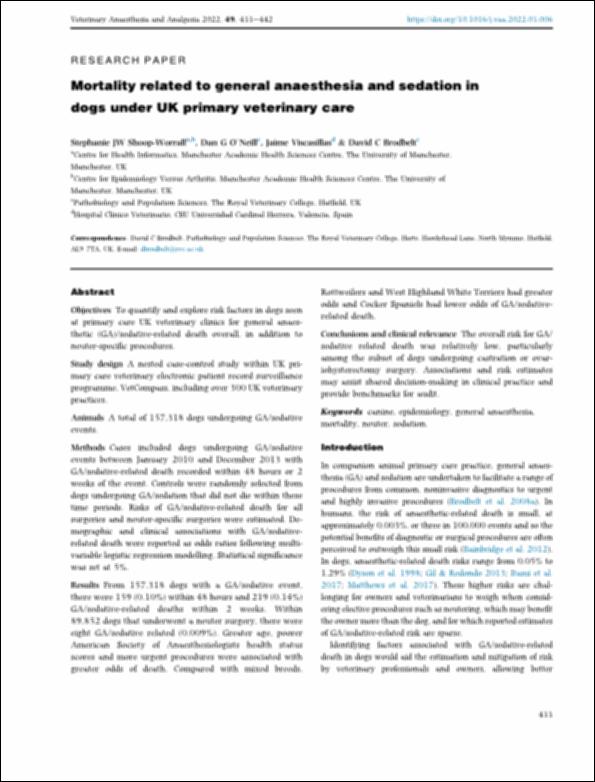Por favor, use este identificador para citar o enlazar este ítem:
http://hdl.handle.net/10637/14196Mortality related to general anaesthesia and sedation in dogs under UK primary veterinary care
| Título : | Mortality related to general anaesthesia and sedation in dogs under UK primary veterinary care |
| Autor : | Shoop-Worrall, Stephanie J. W. O'Neill, Dan G. Viscasillas Monteagudo, Jaime Brodbelt, David C. |
| Materias: | Perros - Cirugía - Factores de riesgo.; Anestesia veterinaria.; Mortality.; Mortalidad.; Veterinary anesthesia.; Dogs - Surgery - Risk factors. |
| Editorial : | Elsevier |
| Citación : | Shoop-Worrall, S. J., O'Neill, D. G., Viscasillas, J. & Brodbelt, D. C. (2022). Mortality related to general anaesthesia and sedation in dogs under UK primary veterinary care. Veterinary Anaesthesia and Analgesia, vol. 49, i. 5 (sep.), pp. 433–442. DOI: https://doi.org/10.1016/j.vaa.2022.03.006 |
| Resumen : | Objectives To quantify and explore risk factors in dogs seen at primary care UK veterinary clinics for general anaesthetic (GA)/sedative-related death overall, in addition to neuter-specific procedures. Study design A nested case-control study within UK primary care veterinary electronic patient record surveillance programme, VetCompass, including over 300 UK veterinary practices. Animals A total of 157,318 dogs undergoing GA/sedative events. Methods Cases included dogs undergoing GA/sedative events between January 2010 and December 2013 with GA/sedative-related death recorded within 48 hours or 2 weeks of the event. Controls were randomly selected from dogs undergoing GA/sedation that did not die within these time periods. Risks of GA/sedative-related death for all surgeries and neuter-specific surgeries were estimated. Demographic and clinical associations with GA/sedativerelated death were reported as odds ratios following multivariable logistic regression modelling. Statistical significance was set at 5%. Results From 157,318 dogs with a GA/sedative event, there were 159 (0.10%) within 48 hours and 219 (0.14%) GA/sedative-related deaths within 2 weeks. Within 89,852 dogs that underwent a neuter surgery, there were eight GA/sedative related (0.009%). Greater age, poorer American Society of Anaesthesiologists health status scores and more urgent procedures were associated with greater odds of death. Compared with mixed breeds, Rottweilers and West Highland White Terriers had greater odds and Cocker Spaniels had lower odds of GA/sedativerelated death. Conclusions and clinical relevance The overall risk for GA/ sedative related death was relatively low, particularly among the subset of dogs undergoing castration or ovariohysterectomy surgery. Associations and risk estimates may assist shared decision-making in clinical practice and provide benchmarks for audit. |
| Descripción : | Este artículo se encuentra disponible en la siguiente URL: https://www.vaajournal.org/action/showPdf?pii=S1467-2987%2822%2900101-5 |
| URI : | http://hdl.handle.net/10637/14196 |
| Derechos: | http://creativecommons.org/licenses/by-nc-nd/4.0/deed.es |
| ISSN : | 1467-2987 1467-2995 (Electrónico) |
| Idioma: | es |
| Fecha de publicación : | 4-sep-2022 |
| Centro : | Universidad Cardenal Herrera-CEU |
| Aparece en las colecciones: | Dpto. Medicina y Cirugía Animal |
Los ítems de DSpace están protegidos por copyright, con todos los derechos reservados, a menos que se indique lo contrario.


